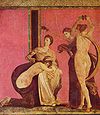Vesta (mythology)

|
Ancient Roman Religion |
|
| Main doctrines | |
| Polytheism & Numen Mythology Imperial Cult · Festivals |
|
| Practices | |
|
Temples · Funerals |
|
|
Ceres · Diana · Juno |
|
| Texts | |
| Sibylline Books · Sibylline oracles Aeneid · Metamorphoses The Golden Ass |
|
| See also: | |
| Persecution · Nova Roma Greek polytheism |
Vesta was the virgin goddess of the hearth, home, and family in Roman mythology. Although she is often mistaken as analogous to Hestia in Greek mythology; she had a large, albeit mysterious role in Roman religion long before she appeared in Greece. Vesta was much more important to the Romans than Hestia was to the Greeks. Little is known about the goddess, as unlike other Roman deities, she had no distinct personality, was never depicted and went without mention in myths. Vesta's presence was symbolized by the sacred fire that burned at her hearth and temples.
Contents |
Vestales
Vesta's (in some versions she is called Vestia) fire was guarded at her Temples by her priestesses, the Vestales. Every March 1 the fire was renewed. It burned until 391, when the Emperor Theodosius I forbade public pagan worship. One of the Vestales mentioned in mythology was Rhea Silvia, who with the God Mars conceived Romulus and Remus (see founding of Rome).
The Vestales were one of the few full time clergy positions in Roman religion. They were drawn from the patrician class and had to observe absolute chastity for 30 years. It was from this that the Vestales were named the Vestal virgins. They could not show excessive care of their person, and they must not let the fire go out. The Vestal Virgins lived together in a house near the Forum (Atrium Vestae), supervised by the Pontifex Maximus. On becoming a priestess, a Vestal Virgin was legally emancipated from her father's authority and swore a vow of chastity for 30 years. This vow was so sacred that if it were broken, the Vestal was buried alive in the Campus Sceleris ('Field of Wickedness'). It is likely that this is what happened to Rhea Silvia. They were also very independent and had many privileges that normal women did not have. They could move around the city but had to be in a carriage.

Vestalia
Vesta was celebrated at the Vestalia which took place from June 7 to June 15. On the first day of the festivities the penus Vestae (the curtained sanctum sanctorum of her temple) was opened, for the only time during the year, for women to offer sacrifices in. Such sacrifices included the removal of an unborn calf from a pregnant cow.
Household worship
Vesta was the goddess of the hearth at the centre of atrium and home. It was in the house and home that Vesta was most important as she was the goddess of the hearth and of fire. Vesta was particularly important to women of the household as the hearth was the place where food was prepared and next to it the meal was eaten with offerings being thrown into the fire to seek omens (the future) from the way it burned. Her weakness was that she couldn't fall in love.
See also
- Roman religion: Roman festivals, Roman mythology, Founding of Rome, Hestia, Caca, Juturna, Vestal Virgin, Similarities between Roman, Greek, and Etruscan mythologies
- Other: Rhea Silvia, Romanian mythology, Pontifex Maximus, List of deities, Amulius
- The asteroid 4 Vesta
|
|||||||||||||||||||
